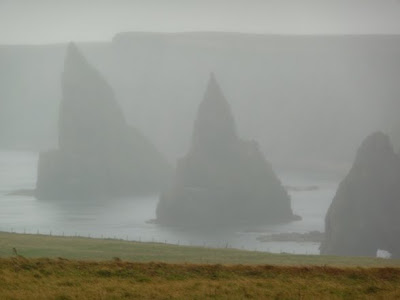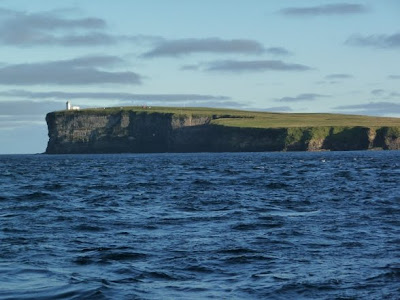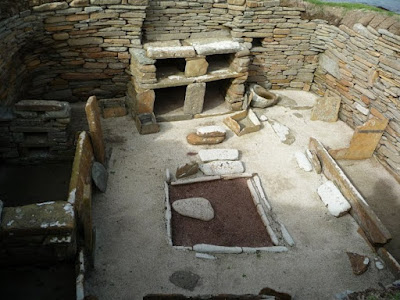We drove on the few miles through Wick, then on to John O' Groats, the traditional Land's End of Scotland (but not really; that's Dunnet Head, a few miles west; and north), which is basically the ferry landing plus a few wind-blown tourist shops, hotel and B&B, tourist office, campground, and car park. We made inquiries at the ferry office and resolved to stretch their “maxi-day” tour of the Orkneys into two, so we could see Maeshowe, the Highland Park distillery, and a few other things. We'll stay overnight at a B&B in Kirkwall. And the Grey Wanderer will stay here in John O' Groats while we are in the Orkneys. After lunch, we drove out to the lighthouse at Duncansby Head, and pretty much stayed in the Grey Wanderer the rest of the day, weathering a hurricane on the cliff overlooking Pentland Firth and its tremendous storms and tidal flows. It's where the Atlantic meets the North Sea. But all you can see today is gray—the sea a slightly darker gray than the sky. Nothing of the skerries and islands just a few miles away and just a bit of the famous sea stacks further down the head. We'll spend the night at a lay-by on the sea just west of John O' Groats, Gill's Bay.
Why the Orkneys, you ask? Well, one reason is the megalitihic stuff. Along with Wiltshire, the River Boyne, and the Gulf of Morbihan, the Orkneys are one of the four or five great neolithic complexes of Europe. We've seen most all of the others, but not this one. We've been reading about it for thirty years. Second, for me, the Orkneys are an historic WWII site, Scapa Flow the great British fleet anchorage into which Gunther Prien's U-47 sailed, on the surface, in October, 1939, and sank the battleship Royal Oak. After the armistice, in 1918, it is also the place where the German High Seas Fleet scuttled itself, 74 capital ships to the bottom, in 1919. And, lastly, but most vitally, the Orkneys are home to that greatest of all spirits, my long-time favorite, Highland Park single malt whisky.
And, finally, you ask, who was John O' Groats? A martyred saint from the Western Isles? A fierce Viking raider or explorer? Another traitorous Jacobite sympathizer? What is a groat, anyway?
Answer: none of the above. James IV commissioned Jan de Groot and his brothers to operate a ferry service to the Orkney Islands from here in 1496. Scotland had acquired the Orkneys from Norway via royal marriage in 1468. Bonnie Jan O' Groots!
 |
| Fixer-upper castle near Wick; waterfront view |
 |
| The Duncansby sea stacks, impressive even in a hurricane |
 |
| A few days later, after our return from the Orkneys |
 |
| Duncansby Head from the Pentland Firth, fair weather... |
 |
John O'Groats Ferry Service, family-owned
and operated since 1496 (well, maybe not the
same family) |
 |
Bluff, New Zealand, 12,875 miles; sort of ties
things together... |

















































